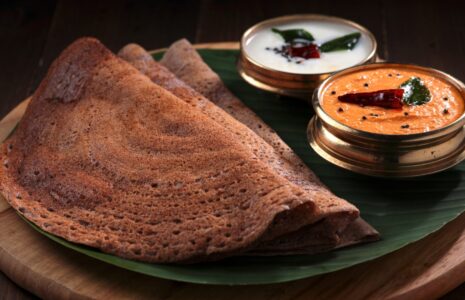No products in the cart.: ₹0.00
Introduction
Ragi flour, also known as finger millet flour, is a nutritional powerhouse that has gained popularity due to its health benefits. In this blog, brought to you by NutriTokri, we will guide you through a delightful recipe for Ragi Dosa, a healthier version of the traditional South Indian dosa. Packed with nutrients and flavor, these ragi dosas are perfect for a wholesome breakfast or a light meal.
Why Choose Ragi Flour for DOSA?
Ragi flour offers several advantages when used in dosa preparation:
- Nutritional Benefits: Ragi flour is rich in dietary fiber, calcium, iron, and essential amino acids. It promotes digestion, aids in bone health, boosts energy levels, and supports overall well-being.
- Gluten-Free Alternative: Ragi flour is naturally gluten-free, making it an excellent choice for individuals with gluten sensitivities or those following a gluten-free diet. You can enjoy dosas without worrying about gluten-related issues.
- Low Glycemic Index: Ragi has a low glycemic index, meaning it releases glucose slowly into the bloodstream. This helps regulate blood sugar levels and keeps you feeling full for longer, making it an ideal choice for individuals with diabetes or those seeking weight management.
Ingredients
- 1 cup NUTRITOKRI’s Ragi flour.
- 1/2 cup rice flour
- 1/2 cup urad dal (split black lentils)
- 1/2 teaspoon fenugreek seeds (methi seeds)
- Salt to taste
- Water, as needed
- Oil or ghee, for cooking
Instructions
- Wash the urad dal and fenugreek seeds. Soak them in water for about 4-6 hours. Rinse the dal and fenugreek seeds, and grind them to a smooth batter consistency with a little water.
- In a mixing bowl, combine the ragi flour, rice flour, and the urad dal batter. Add salt and mix well. The batter should be of pouring consistency. If needed, add water gradually to achieve the desired consistency.
- Allow the batter to ferment overnight or for at least 6-8 hours in a warm place. Fermentation improves the flavor and texture of the dosas.
- After fermentation, gently mix the batter. Heat a dosa tawa or non-stick skillet on medium heat. Once hot, spread a ladleful of the batter in a circular motion to form a thin dosa.
- Drizzle a little oil or ghee around the dosa and cook until the edges turn crispy and golden brown. Flip the dosa and cook for a minute on the other side.
- Remove the ragi dosa from the tawa and repeat the process with the remaining batter.
- Serve the ragi dosas hot with sambar, coconut chutney, or any other accompaniment of your choice.
Conclusion
NutriTokri invites you to enjoy the wholesome goodness of Ragi Dosa, a nutritious twist to the traditional South Indian delicacy. By incorporating ragi flour, you not only enhance the taste but also boost the nutritional value of your dosas. Ragi dosas are an excellent option for those looking for gluten-free, low glycemic index, and nutrient-rich breakfast or meal options. Prepare these delicious dosas with NutriTokri’s recipe and savor the fusion of health and flavor on your plate!
Note: You can experiment with additional ingredients like finely chopped onions, grated carrots, spinach, or other vegetables to add more texture and flavor to your ragi dosas.






